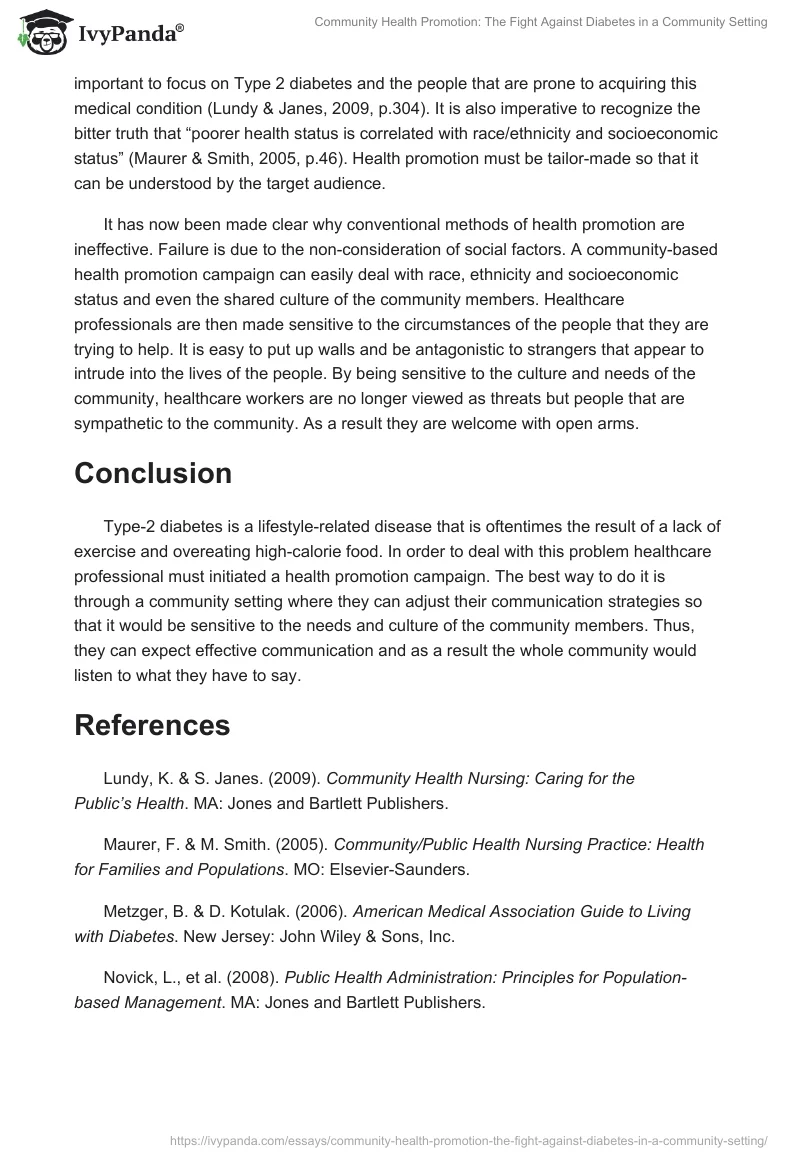A community is established when a group of individual’s band together because of shared values. The concept of community has been brought up in the context of health promotion. Healthcare professionals are aware that there are limitations when it comes to using conventional methods in health promotion. Thus, it is extremely difficult to help those who are in need. This is especially true when it comes to lifestyle-related diseases such as Type 2 diabetes. It is imperative that healthcare workers to promote health in the context of a community in order to ensure effective communication and better results.
Background
In the past, Type 2 diabetes was linked to old age. However, in the past few decades, a sedentary lifestyle coupled with excessive consumption of high-calorie food has brought about a health crisis. Men and women under the age of forty are suffering from Type 2 diabetes. In the United States alone, 85 to 90 percent of people with type 2 diabetes are overweight (Metzger & Kotulak, 2006, p.10). It is nearing epidemic levels and many families are suffering because of medical expenses and shortened lifespan. It is therefore imperative to inform the public on how to prevent Type 2 diabetes. But it was discovered that traditional means of health promotion is not effective. There is a need to go to the community level in order to increase the effectiveness of health promotion.
Community and Health
According to experts in community healthcare, communicating with the community is the most rewarding when it comes to public health because successful communication results in protection or promotion of the health of the community (Novick et al., 2008, p.575). Applying principles of community-based health promotion it is important to focus on Type 2 diabetes and the people that are prone to acquiring this medical condition (Lundy & Janes, 2009, p.304). It is also imperative to recognize the bitter truth that “poorer health status is correlated with race/ethnicity and socioeconomic status” (Maurer & Smith, 2005, p.46). Health promotion must be tailor-made so that it can be understood by the target audience.
It has now been made clear why conventional methods of health promotion are ineffective. Failure is due to the non-consideration of social factors. A community-based health promotion campaign can easily deal with race, ethnicity and socioeconomic status and even the shared culture of the community members. Healthcare professionals are then made sensitive to the circumstances of the people that they are trying to help. It is easy to put up walls and be antagonistic to strangers that appear to intrude into the lives of the people. By being sensitive to the culture and needs of the community, healthcare workers are no longer viewed as threats but people that are sympathetic to the community. As a result they are welcome with open arms.
Conclusion
Type-2 diabetes is a lifestyle-related disease that is oftentimes the result of a lack of exercise and overeating high-calorie food. In order to deal with this problem healthcare professional must initiated a health promotion campaign. The best way to do it is through a community setting where they can adjust their communication strategies so that it would be sensitive to the needs and culture of the community members. Thus, they can expect effective communication and as a result the whole community would listen to what they have to say.
References
Lundy, K. & S. Janes. (2009). Community Health Nursing: Caring for the Public’s Health. MA: Jones and Bartlett Publishers.
Maurer, F. & M. Smith. (2005). Community/Public Health Nursing Practice: Health for Families and Populations. MO: Elsevier-Saunders.
Metzger, B. & D. Kotulak. (2006). American Medical Association Guide to Living with Diabetes. New Jersey: John Wiley & Sons, Inc.
Novick, L., et al. (2008). Public Health Administration: Principles for Population-based Management. MA: Jones and Bartlett Publishers.


